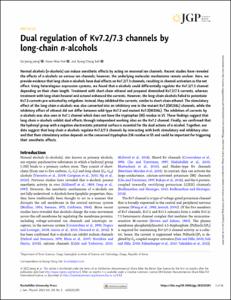Dual regulation of Kv7.2/7.3 channels by long-chain n-alcohols
- Title
- Dual regulation of Kv7.2/7.3 channels by long-chain n-alcohols
- Author(s)
- Jeong, Da-Jeong ; Kim, Kwon Woo ; Suh, Byung-Chang
- Issued Date
- 2023-02
- Citation
- Journal of General Physiology, v.155, no.2, pp.1 - 16
- Type
- Article
- Keywords
- RECEPTOR-MEDIATED INHIBITION ; POTASSIUM CHANNELS ; ANTICONVULSANT RETIGABINE ; ANESTHETIC POTENCIES ; GANGLION NEURONS ; BINDING-SITE ; MODULATION ; ACTIVATION ; ALKANOLS ; ETHANOL
- ISSN
- 0022-1295
- Abstract
- Normal alcohols (n-alcohols) can induce anesthetic effects by acting on neuronal ion channels. Recent studies have revealed the effects of n-alcohols on various ion channels; however, the underlying molecular mechanisms remain unclear. Here, we provide evidence that long-chain n-alcohols have dual effects on Kv7.2/7.3 channels, resulting in channel activation as the net effect. Using heterologous expression systems, we found that n-alcohols could differentially regulate the Kv7.2/7.3 channel depending on their chain length. Treatment with short-chain ethanol and propanol diminished Kv7.2/7.3 currents, whereas treatment with long-chain hexanol and octanol enhanced the currents. However, the long-chain alcohols failed to potentiate Kv7.2 currents pre-activated by retigabine. Instead, they inhibited the currents, similar to short-chain ethanol. The stimulatory effect of the long-chain n-alcohols was also converted into an inhibitory one in the mutant Kv7.2(W236L) channels, while the inhibitory effect of ethanol did not differ between wild-type Kv7.2 and mutant Kv7.2(W236L). The inhibition of currents by n-alcohols was also seen in Kv7.1 channel which does not have the tryptophan (W) residue in S5. These findings suggest that long-chain n-alcohols exhibit dual effects through independent working sites on the Kv7.2 channel. Finally, we confirmed that the hydroxyl group with a negative electrostatic potential surface is essential for the dual actions of n-alcohol. Together, our data suggest that long-chain n-alcohols regulate Kv7.2/7.3 channels by interacting with both stimulatory and inhibitory sites and that their stimulatory action depends on the conserved tryptophan 236 residue in S5 and could be important for triggering their anesthetic effects. © 2022 Jeong et al. This article is distributed under the terms of an Attribution–Noncommercial–Share Alike–No Mirror Sites license for the first six months after the publication date (see http://www.rupress.org/terms/). After six months it is available under a Creative Commons License (Attribution–Noncommercial–Share Alike 4.0 International license, as described at https://creativecommons.org/licenses/by-nc-sa/4.0/).
- Publisher
- Rockefeller University Press
- Related Researcher
-
-
Suh, Byung-Chang
- Research Interests Molecular mechanisms of epilepsy and sensory pain transmission; Signaling mechanism of ion channel regulation and membrane excitability; 분자전기생리; 간질 및 통증의 분자적 기전 연구
-
- Files in This Item:
-
 기타 데이터 / 5.48 MB / Adobe PDF
download
기타 데이터 / 5.48 MB / Adobe PDF
download
- Appears in Collections:
- Department of Brain Sciences Laboratory of Brain Signal and Synapse Research 1. Journal Articles



